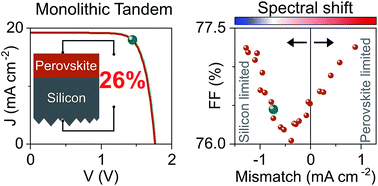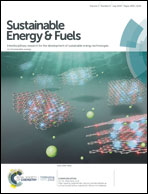Highly efficient monolithic perovskite silicon tandem solar cells: analyzing the influence of current mismatch on device performance†
Abstract
Metal halide perovskites show great promise to enable highly efficient and low cost tandem solar cells when being combined with silicon. Here, we combine rear junction silicon heterojunction bottom cells with p–i–n perovskite top cells into highly efficient monolithic tandem solar cells with a certified power conversion efficiency (PCE) of 25.0%. Further improvements are reached by reducing the current mismatch of the certified device. The top contact and perovskite thickness optimization allowed increasing the JSC above 19.5 mA cm−2, enabling a remarkable tandem PCE of 26.0%, however with a slightly limited fill factor (FF). To test the dependency of the FF on the current mismatch between the sub-cells, the tandems' J–V curves are measured under various illumination spectra. Interestingly, the reduced JSC in unmatched conditions is partially compensated by an enhancement of the FF. This finding is confirmed by electrical simulations based on input parameters from reference single junction devices. The simulations reveal that especially the FF in the experiment is below the expected value and show that with improved design we could reach 29% PCE for our monolithic perovskite/silicon tandem device and 31% PCE if record perovskite and silicon cell single junctions could be combined in tandem solar cells.



 Please wait while we load your content...
Please wait while we load your content...